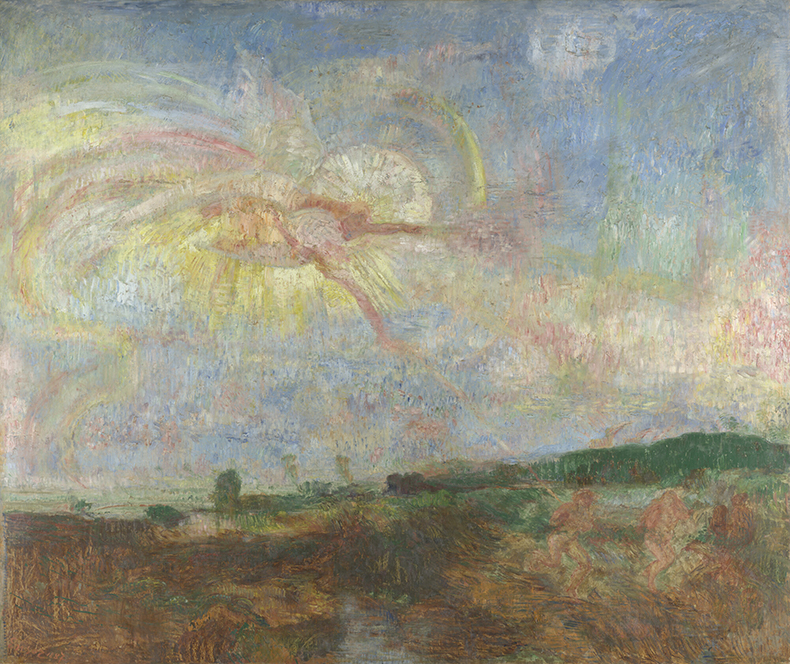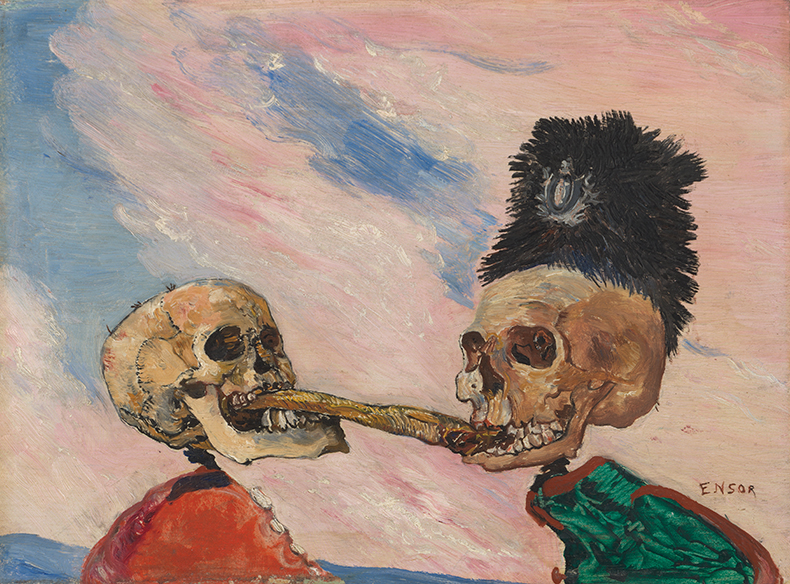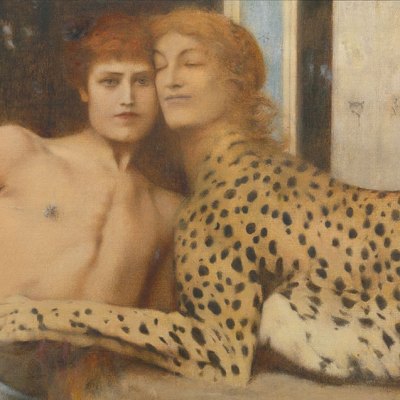James Ensor has long been regarded as a maverick. Most celebrated – and rightly so – for his fantastical, often satirical images of the ghoulish and the grotesque, this ‘master of the mask’ has been cast as the consummate outsider. The notion was that this painter, draughtsman and etcher worked away alone and misunderstood in the garret above the family curiosity shop in Ostend, haunted by its contents. However, ‘In Your Wildest Dreams: Ensor Beyond Impressionism’ at the Royal Museum of Fine Arts in Antwerp (KMSKA) – resoundingly knocks the final nail into this coffin. Moreover, the diversity of the artist’s work – once considered the reason for the difficulty in placing him within a movement or historical continuum – is revealed here to set him firmly in the context of the European avant-garde. Ensor, we learn, is less a slippery fish than a red herring.
‘Ensor Year’, a series of celebrations marking the 75th anniversary of the artist’s death, was launched in his seaside hometown, progressed to Brussels, where he studied between 1877 and 1880, and now culminates in four distinct exhibitions in Antwerp. The city is a fitting place for his apotheosis, given that the KMSKA holds the largest and most varied collection of his work and established the technical Ensor Research Project in 2013. To these, curator Herwig Todts has added judicious loans by a wide range of masters to present a show that is as visually engaging and whimsical as it is serious and illuminating.
The Oyster Eater (1882), James Ensor. Royal Museum of Fine Arts Antwerp

Light, as it happens, was an early and enduring preoccupation of Ensor; the exhibition might equally have been subtitled ‘Beyond the Mask’. To establish his progressive credentials, the ambitious young artist sought to embrace the experiments of French Impressionism without – it soon becomes apparent – ever having seen any at first hand. Even so, his ‘bright’, Manet-inspired The Oyster Eater was duly refused by the 1882 Antwerp Salon. It was not until Les XX, the exhibition society he founded with like-minded artists the following year, invited guests from abroad that the likes of Renoir and Monet, the Symbolist Odilon Redon and the Post-Impressionists Gauguin, Van Gogh and Seurat were shown on Belgian soil. Yet this pattern of borrowing from black-and-white reproductions – whether magazines or prints – of art old and new had been established, and it continued to result in unexpected colouristic effects. That said, Ensor relished exaggerating his borrowings from the first.
The two figures in the sombre social realist painting The Drunkards (1883), for instance, are far more desperate than those of Jean-François Raffaëlli’s The Absinthe Drinkers, on which his canvas is based. The Scandalized Masks of the same year – Ensor’s first foray into masquerade – further transformed the pair into a gritty, low-life Punch and Judy. Even in the sedate and muted Russian Music (1881), the highly patterned carpet of this Nabis-style interior threatens to riot.
Adam and Eve Expelled from Paradise (1887), James Ensor. Royal Museum of Fine Arts Antwerp

Another hero was Courbet. From the French artist Ensor learned how to wield a palette knife to richly impasted and dramatic effect, and to reduce his subject-matter to the bare essentials of skies and seas with low horizons, as in The White Cloud or Large View over the Rooftops of Ostend (both 1884). A low horizon also features in Adam and Eve Expelled from Paradise (1887). The handling and warm, vibrant colour of this important work, however, derive from Mediterranean landscapes by Monet, presented here as comparisons, as they were exhibited by Les XX in 1886. In another turn, Ensor looks to the mezzotints of John Martin to find his compositions; the prints may well have belonged to Ensor’s cultivated English father, a drunk who was found dead on an Ostend street in 1887 – the year the picture was painted. It is easy to understand why Ensor’s biography is emphasised in interpretations of his work. And surely another master of the sublime, J.M.W. Turner – rather than Monet – was the compositional source for Christ Calming the Storm (1891). Its vortex directly echoes that of the British painter’s notorious Snow Storm – Steam-Boat off a Harbour’s Mouth (1842).
View of Bordighera (1884), Claude Monet. Hammer Museum, Los Angeles

While Ensor kept to an Impressionist palette all his life, his concerns soon transcended mere representation. This was probably the result of his encounter with Redon’s hallucinatory jet-black lithographs and drawings, which prompted his own series of large drawings, ‘Visons: The Aureoles of Christ or the Sensibilities of Light’. Despite the choice of ostensibly biblical subject-matter, Ensor seems to have been ambivalent about religion. Perhaps he simply relished the pictorial possibilities, although he later wrote of wanting to ‘express passion, disquiet, struggle, pain, enthusiasm and poetry’. In these early years, he was also looking to the paintings, drawings and prints of Rembrandt, a genius manipulator of light. Like many artists, Ensor was a magpie, but what makes him unusual is the range and eclecticism of his interests. In Antwerp, we can see him borrowing from too many artists to list here. Apart from his European and Japanese contemporaries, influences include the obvious Bosch, Bruegel and Goya, but also Michelangelo and Watteau.
Yet Ensor was equally drawn to popular culture. One of the delights of the exhibition is a magic lantern show that we know the artist saw. With a cast of skulls, skeletons and animal-headed humans, the mix of the macabre, the creepy and the downright funny is pure Ensor. On display, too, beside posters for burlesque shows and cabarets, are puppets and the Noh theatre masks and carnival masks of the kind Ensor ordered for the family shop. Yet while his contemporaries painted scenes of carnival with people wearing masks, Ensor’s masks are alter egos. These masks were not intended to conceal but to expose. These dark paintings done in a deceptively light and pretty palette present grotesque reflections of the follies, weaknesses, corruptions and hypocrisies of mankind. Despite their humour, only relatively few of his images of ludicrously dressed skeletons can be regarded as delightful or absurd.
The Temptation of Saint Anthony (1887), James Ensor. Art Institute of Chicago. Photo: © Art Institute of Chicago/Art Resource, NY/Scala, Florence

Perhaps most extraordinary of all is the monumental hallucinatory drawing on loan from the Art Institute of Chicago. The Temptation of Saint Anthony evolved piecemeal and comprises some 51 sketchbook sheets pasted together on canvas to form a single composition. Long a favoured subject for artists such as Bosch and Grünewald, and for puppeteers at country fêtes, it had been recently revisited by the likes of Flaubert in literature and in art by Félicien Rops and by Henri Rivière, whose immersive, theatrical magic lantern show at Le Chat Noir in Paris used it for a swingeing critique of contemporary society. Ensor reimagines the hermit’s struggles as a dystopian spreading crowd of masks, skeletons, animal-human hybrids and other grotesques in outlandish scenes – partly inspired by Flaubert’s prose play of the same title – that also address current social and political concerns. Tiny, detailed vignettes in the drawing offer a visceral mix of the cruel, droll and indecent.
Ensor was always part of the progressive Belgian mainstream, interested in what was happening in the worlds of literature, music as well as art in Brussels and beyond. Even his conservative detractors recognised his pre-eminence, and Ensor was so delighted by a mocking picture of his work, The Dried Herring, that he adopted the fish as an alter ego and had two skeletons fighting over one. The exhibition places the artist in the pan-European context of Symbolism, of Munch (whose work he did not know), and the German Expressionists who revered him. Is the artist diminished by his absorption into the real world? Not one bit; it only enriches our understanding of an artist who totally reinvented his art every two or three years. And it is this curiosity and constant exploration of different styles, subjects, genres, techniques and media that reveals Ensor as a modernist before his time.
Skeletons Fighting over a Pickled Herring (1891), James Ensor. Royal Museums of Fine Arts of Belgium

‘In your Wildest Dreams: Ensor beyond Impressionism’ is at the Museum of Fine Arts Antwerp until 19 January 2025. Also part of the Ensor 2024 season: ‘Ensor’s States of Imagination’ is at the Museum Plantin-Moretus until 19 January 2025. ‘Masquerade, Make-up & Ensor’ is at MoMu – Fashion Museum Antwerp until 2 February 2025. ‘Cindy Sherman’ is at FOMU – Photo Museum Antwerp until 2 February 2025.



